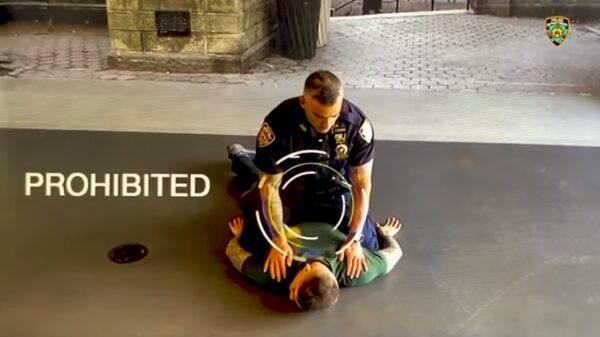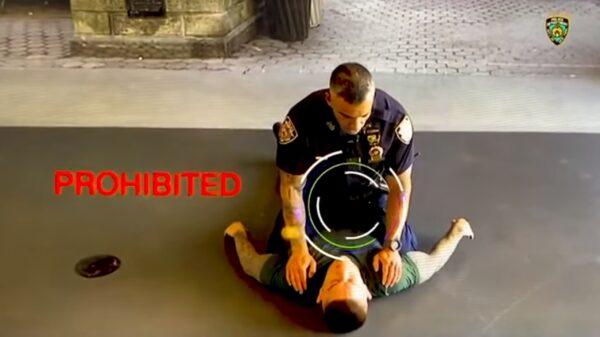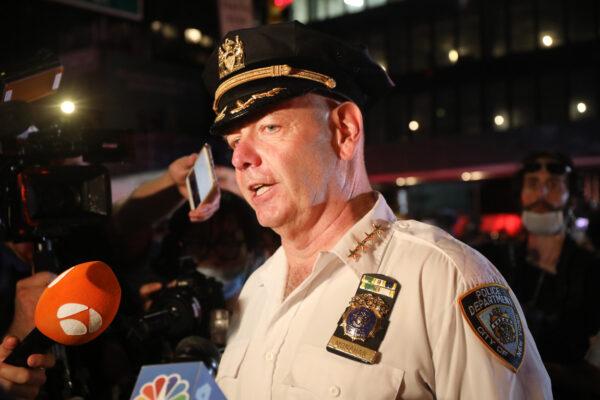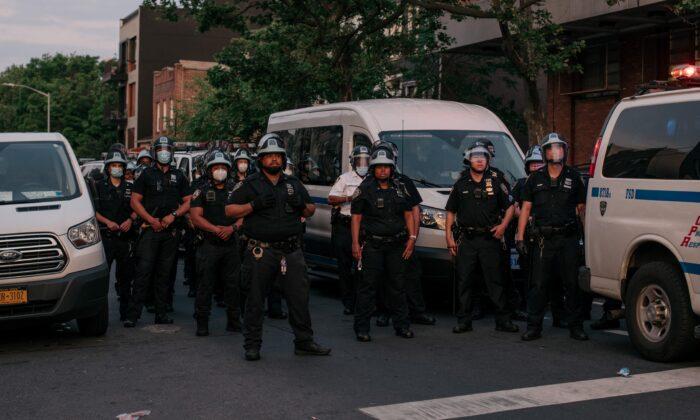New restrictions the New York City government placed on its police, the NYPD, are so ill-conceived that they'll lead to more police brutality, not less, based on nearly a dozen interviews The Epoch Times conducted with current and former police officers, martial arts instructors, police tactics experts, and lawyers representing police officers or people alleging police brutality.
Police will thus have to resort to other methods that are often more violent and put both the officers and the people they attempt to arrest in greater danger.
The problematic part of the bill, signed into law by Mayor Bill de Blasio on July 15, states that “no person shall restrain an individual in a manner that restricts the flow of air or blood by ... sitting, kneeling, or standing on the chest or back in a manner that compresses the diaphragm, in the course of effecting or attempting to effect an arrest.”
Such positions are virtually unavoidable if the police are to arrest a resisting subject without using a baton, taser, or a gun, according to Rener Gracie, a martial arts instructor who’s been teaching law enforcement nonviolent defensive techniques from Brazilian jiu-jitsu for more than 20 years.
“Every single one of them [arrests] in which the police is successful ... included momentary, at the very least, pressure on the diaphragm of the subject,” said Gracie, who routinely analyzes use-of-force incidents and recommends how to handle them better.
Conversely, arrests that fail or escalate to higher levels of violence are usually those where the officers failed to pin the subject down, he said.

It was Gracie’s grandfather who co-founded the martial arts style of Brazilian jiu-jitsu. In the 1990s, the family was invited on a panel to help the LAPD update its defensive tactics curriculum after the Rodney King incident. They have been providing train-the-trainer courses to law enforcement since, and are currently certifying over a thousand law enforcement instructors a year.
Several current and former police officers spoke highly of the art, particularly for teaching officers how to pacify suspects without harming them and how to keep one’s cool during a fight.
Decades of progress achieved by Gracie and others in the field of police use of force tactics are now threatened to be undone if the NYC law is to spread to other jurisdictions.

“It’s now going to make it impossible for police officers to overpower somebody without hurting them,” said Robert Brown, former NYPD captain and now a criminal lawyer, in a phone call with The Epoch Times.
The law is worded so broadly as to make it illegal even when an officer ends up in one of the forbidden positions accidentally and the suspect suffers no injury. Brown thinks this may make it unconstitutional since it criminalizes unintentional conduct, “which is OK in a civil case ... but they’re applying it in a criminal realm.”
Surge in Crime
The new law comes at a time the city is swept in a wave of violence unseen since the crack epidemic of the 1990s. More than 320 people were shot (fatally or nonfatally) in the four weeks ending July 19, up more than 200 percent from the same period last year. Murder is up 24 percent this year compared to last year.“Until they change this law, arrests will continue to plummet in New York City, which means the violence continues to surge,” Giacalone said. “Because there’s zero repercussions for the politicians of New York City.”
Officers are already weighing their options, according to an NYPD detective, who asked for his name to be withheld as he wasn’t authorized to talk to the media.
“Do I want to even stop this guy? Do I want to arrest this guy? It’s not worth it. It’s not worth my job or my livelihood,” he described the thought process.
Patrol officers in his precinct will “go to the job and do the basic amount of work,” he said. Proactive policing has virtually ceased.
Meanwhile, hundreds of NYPD officers are filing for retirement, and the local police union reports the lowest morale in decades.
“The new diaphragm law has frightened many, many police officers. Everybody’s saying how can we possibly do our job?” Brown said in a phone call. “Anybody that’s ever been a police officer, that’s ever been in a fight with somebody, realizes they’ve now made it impossible to do the job.”
Indeed, officers should be frightened, Giacalone said.
“When you’re struggling with somebody who is uncooperative, anything can happen. And you’re in a fight for your life, and to say that you can’t do this and can’t do that as you’re rolling around with somebody, if the cop is thinking about it, is extremely dangerous to them, to their life,” he said.
Gracie said he’s been hearing from officers across the country who fear similar measures may come to their jurisdiction.
“We can’t be afraid,” he shouted during the July 23 internal meeting.

Escalation of Force
So what options do the officers have?New York law still authorizes officers to use a necessary level of force to subdue a resisting subject. With many of the nonviolent measures now taken off the table, officers will have to resort to more violent methods—including batons, tasers, and even guns.
“Good officers will become bad officers because policy doesn’t allow good policing anymore,” Gracie said.
Giacalone concurred.
“There’s going to be a lot of use of pepper spray, batons, and other nonlethal weapons to get people under control,” the former NYPD detective sergeant said.
What most civilians don’t understand is that arresting a resisting person is never easy, even for a well-trained officer.
“If somebody doesn’t want to get arrested, I don’t care how big or small they are, it’s nearly impossible to make that arrest unless there’s some sort of overwhelming force against them,” Giacalone said.
Sometimes it takes four or five officers to pacify a 100-pound woman who doesn’t want to go to jail, he said.
Brown said, “In real life, it’s not like a training video ... it doesn’t go cleanly.”
As the NYPD detective put it, resistance is common.
“Ninety-nine percent of people we arrest do not want to be arrested,” he said. “So they’re going to fight, which is the normal.”
Moreover, the NYC law will encourage people to resist, said an NYPD lieutenant who asked for his name to be withheld as he wasn’t authorized to talk to the media.
“A law like this will empower people to resist, knowing that officers will be reluctant to go hands-on,” he said in a phone call.
Even when the person isn’t outright attacking the officers, but simply doesn’t want to get handcuffed or is trying to slip out, it makes the arrest “extremely difficult,” said a police officer responsible for tactical training in a large metropolitan police department. The officer asked for his name to be withheld as he wasn’t authorized to talk to the media.
His department has been using GST for many years. What NYC has done is “taking away a very important tool to use humane, proportional force,” he said in a phone call.
There are other methods, but those not only tend to be less advantageous, but also “very inflammatory appearing,” as he put it.
Police have long been trained, for instance, to use the brachial stun, where the officer hits a suspect to the side of the neck with his forearm, palm, or fist. The hit aims at the carotid arteries and can stun or even knock out the subject.
The strike is “relatively safe” the officer said, but it “looks inflammatory” for bystanders.
“It’s reasonable for them to assume the officer’s punching him out of anger,” he said.
Some police departments have taught officers to use pressure points or other “pain compliance” methods. In theory, grabbing and pressing the points should put the subject in intolerable pain and force compliance. The problem is, the technique doesn’t always work. Intoxicated people, people undergoing mental crises, or even those with a strong sense of determination can have very high pain resistance.
When the suspect is pulling away his arms and refuses to let the officer put the arms behind the back, police used to be commonly trained to strike the suspect in “motor points” around joints.
If the suspect persistently doesn’t comply and tries to keep his hands under his body, officers used to be trained to just strike the subject continuously until forcing compliance.
For bystanders, that simply looks like a beatdown.
“It looks like it’s overuse of force,” the officer said.
Moreover, once the officer loses his cool, he’s likely to have trouble recognizing when the subject stops resisting. And if the officer keeps hitting a person who’s already compliant, the suspect is likely to panic.
“Now you just have a recipe for disaster,” the officer said.
Neurological research has shown that the human prefrontal cortex, which facilitates rational decision making, is sensitive to acute stress. Once inhibited, decisions are taken over by the amygdala, the part of the brain responsible for the more primitive responses, such as fear, anger, submissive behavior, and freezing—"things the society does not want in a police officer,” the officer noted.
“When you get in that mode, there is no if-then calculation, rational calculations,” Gracie explained.
That’s why GST methods place ultimate emphasis on the ability to keep calm during intense physical encounters, such as a street fight. The key, the officer said, is perception of control.
As long as the officer can maintain a sense of control over the situation, even if the control is not completely real, he can keep his senses.
Stripping police of GST tactics will have the opposite effect, he said. “It degrades the perception of control.”
“This was just a pandering law as far as I’m concerned,” Giacalone said.
Lack of Training
If police need something, it’s more hand-to-hand techniques to use, not less, Gracie and several officers said.“Police have always been grossly underprepared to handle unarmed combative subjects or assaultive subjects,” Gracie said. “They simply don’t get the training.”
The “ridiculous truth that is accepted throughout law enforcement” is that officers often get between 4-8 hours of hand-to-hand defense training every year or two, according to Gracie.
That is simply not enough. As Gracie and several current and former police officers confirmed, during a dangerous encounter, when the adrenaline starts to pump, the officer usually reverts to his baseline training, meaning only the part that has, through repetition, become instinctual.
“Now, that lack of training is exacerbated by the fact that so many safe control holds have been stripped away from New York police officers,” Gracie said.
The suspect apparently had some martial arts training, according to Gracie. Had he not released the hold, within a few more seconds the officer could have lost consciousness. That is a situation that, according to NYPD policies, warrants deadly force, he said. That means the officer would have been in the right to pull a gun on the suspect.
There is a GST countermove for this situation, but it would end up with the officer mounting on top of the suspect—a position now illegal for officers to assume.
“It was hard enough to arrest someone before this bill,” he said, while now “it’s virtually impossible to arrest someone resistant.”
Gracie would like to see officers getting several hours of training a week, though a more realistic goal would be at least an hour a week. Even that would make a world of difference, he said.
“Everything would change in America,” he said.
Paradoxically, the recent calls for defunding police would likely hit the training budget first. Departments are usually reluctant to cut personnel, already stretched thin in many cases. The only discretionary part of the budget is training and travel, where travel is usually associated with training, said Lance LoRusso, former police officer and now lawyer specializing on representing officers involved in shootings.
Indeed, NYC’s new $1 billion budget cut to the NYPD hits significantly the police academy, which had its next class canceled.
Better training could also encourage officers to be more vocal about subpar individuals in their midst, Gracie opined.
“Officers around the country know how undertrained they are so they’re very reluctant to speak out against the, I think, the manifestation of the undertraining that another officer receives,” he said.
When officers see one of their peers handling a situation poorly, “I think every officer looks at that and says, ‘Yea, it could have been me. Because I, too, am not prepared to handle that,’ which is also why they don’t speak out against it because they know they could be next,” Gracie said.
The difference between a reasonable person and a reasonable officer makes a major difference, LoRusso explained, because police do think differently.
“Cops start to realize just how quickly dangerous situations occur, just how fast deadly force encounters can erupt,” he said.
What people may not realize is that police are always at a disadvantage in deadly force situations because they should never be the ones who shoot first. An armed suspect can get three shots out in less than a second before the officer manages to assess the situation and shoot back, according to LoRusso.
“Action beats reaction every time,” he said.
Thus, when a suspect doesn’t drop his gun after repeated orders to do so, the officers may shoot the person, even if he doesn’t actually point the gun at the officers.
In LoRusso’s view, it’s simply part of a citizen’s duty, living in a civilized society, to cooperate with law enforcement.
“When you’re told you’re under arrest, you may believe you didn’t do anything wrong, you may believe the officer has the wrong person, but the only lawful appropriate response is to submit to the officer’s authority, allow yourself to be taken into custody, and take the case to court,” he said.
As long as governments have the right to enforce their laws, police have the authority to make arrests and the general rule is that the quicker the arrest goes, the safer. Resistance will be met with force.
Intelligent Reforms
The shame about NYC, Gracie said, is that much of the other policing reforms the city recently adopted were good.The city, for instance, forbade officers from interfering with people recording them from a safe distance. Having a use-of-force incident on camera is the first thing cities need to ensure to reduce police brutality incidents, according to Brian Zeiger, lawyer who represents victims of police brutality in Philadelphia.
His first recommendation was that officers’ body cameras need to turn on automatically so they can’t argue “that the incident was occurring too quickly” for them to switch on the camera manually. Ideally, officers should wear multiple smaller cameras, instead of “one big camera,” he said in a phone call. Also, there should be “real punishment” for officers whose cameras chronically malfunction right around the time they engage in alleged brutality.
Next, police shouldn’t be able to search cars and frisk people on the thinnest of suspicions as the law now allows.
This actually seems to be the real point of friction between effective policing and community acceptance. Stopping people and cars is the most prominent proactive policing tactic. It’s one of the most effective ways to stop criminals from walking around with an illegal gun and to pick up criminals evading arrest, multiple ex-officers confirmed.
The problem is, most of those stops don’t result in an arrest.
“The bulk of the proactive contacts involve people who didn’t do anything wrong, which means they walk away from that encounter possibly and probably with not the best opinion of police officers,” said Leonard Sipes, a former police officer and former communications specialist in the Justice Department.
People see such stops as unjust and, lacking an explanation from the police, they would supply their own.
“The cop stopped me because of my race or the cop stopped me because I’m wearing a yamaka ... fill in the blank,” he said.
But that’s not necessarily the case.
“I have been stopped unfairly by police officers throughout my career. It was not a pleasant experience but I understand what it is that they were doing,” Sipes said.
On some occasions, after he identified himself to the officers, they explained to him why they actually stopped him and “it made sense,” he said.
Sometimes police are looking for a vehicle of a certain description—that can lead to many inquisitive traffic stops of people who haven’t done anything wrong.
Explaining this kind of proactive policing would “require an enormous amount of communication to the public,” Sipes said.
“I don’t know how you can create a communications platform that conveys what proactive policing is, what it does, why it’s important, how it’s important, because all that person knows is ... that they were abruptly stopped by a police officer.”






Friends Read Free